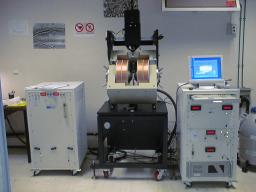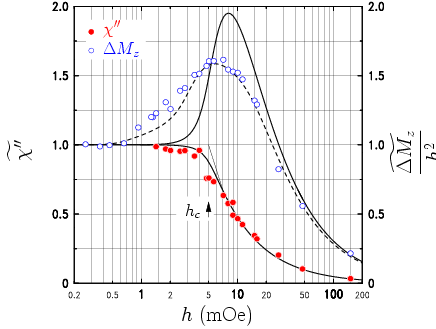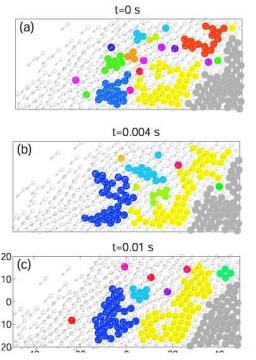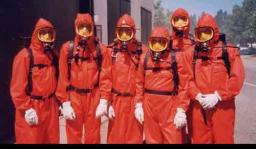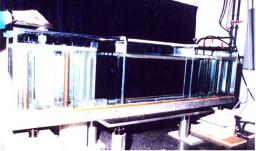2005
Major Results
Quasi-linear model of turbulence We have developed a new quasi-linear model of turbulence in collaboration with J.-P. Laval (Lille University) and S. Nazarenko (Warwick, GB). We have shown that this model allows simple understanding of the small scale intermittency. With J. Mc Williams (UCLA), we have also shown how this model could lead to a stochastic approach of the closure problem of Navier-Stokes equations. This method has been applied to the computation of 2D and 3D energy spectra in fluid turbulence with O. Zagorosvski (Warwick, GB), and to the computation of torques in von Karman experiment. The quasi-linear model of turbulence has also been applied to convection. The scaling laws of the turbulent transport have been derived. Logarithmic corrections to scaling have been obtained. This approach has been generalized to the case of large Prandtl number convection, leading to an explanation for an experimental controversy between several experiments.
Introduction
Dry granular materials are very simple: they are large conglomerations of discrete macroscopic particles. If they are non-cohesive, then the forces between them are essentially only repulsive so that the shape of the material is determined by external boundaries and gravity.
Yet despite this seeming simplicity, granular materials behave differently from any of the other standard and familiar forms of matter : solids, liquids or gases, and should therefore be considered as an additional state of matter in its own right. At the root of this unique status are three important aspects: the existence of static friction, the fact that temperature is effectively zero and, for moving grains, the inelastic nature of their collisions. In some cases, such as a sandpile at rest with a slope less than the angle of repose, static friction produces solid-like behavior: the material remains at rest even though gravitational forces create macroscopic stresses on its surface. If the pile is tilted several degrees above the angle of repose grains start to flow, like in a fluid.
However, this flow is clearly not that of an ordinary fluid because it only exists in a boundary layer at the pile's surface. Also, unlike in an ordinary fluid, kT plays no role in a granular material and entropy considerations can easily be outweighted by dynamical effects that now become of paramount importance. Unless perturbed by external disturbances, each metastable configuration of the material will last indefinitely, and no thermal averaging over nearby configurations will take place. Because each configuration has its unique properties, the reproducibility of granular behavior, even on large scales and certainly near the static limit, can only be defined in terms of ensemble averages.
In order to better understand the dynamical and rheological properties of granular materials, we have investigated surface flows in a rotating drum, then studied the response of a granular pile to a localised surface disturbance. More recently, we have considered the relaxation of a granular pile, following the occurence of an avalanche. Also, we have looked at some application to dunes dynamics and industrial powders flows.
See the IRAMIS highlight and the CEA-CNRS-ENS press release
Web site of the VKS collaboration
Introduction
Dynamo action, the spontaneous generation of a magnetic field in a flow of conducting fluid, is supposed to be at the origin of the planets and stars magnetic fields. A lot of theoretical and numerical work has been devoted to this problem and it has been demonstrated experimentally in constrained model flows in recent experiments in Riga (Ponomarenko flow) and Karlsruhe (Roberts flow). A demonstration in the case of an unconstrained, turbulent flow, closer to the natural case, is still lacking.
This is mainly due to the fact that to build a dynamo, one must use liquid sodium, with all its incumbent dangers. Moreover, the dynamo will work only if the advection of the magnetic field and generation of current are fast compared to dissipation - namely if the magnetic Reynolds number exceeds a critical value, which strongly depends on the geometry of the flow.
Besides Riga and Karlsruhe, there are several groups around the World working on different dynamo projects: Maryland, Wisconsin and Socorro in USA, Perm in Russia and Grenoble and VKS in France. In France, the dynamo community is gathered through the GDR dynamo led by B. Dubrulle.
In collaboration with S. Fauve (ENS Paris), J.F. Pinton and P. Odier (ENS Lyon), we have designed, constructed and run a liquid sodium experiment called von Karman sodium - VKS - in CEA/Cadarache (DEN/DER/STR). The first configurations have been designed after the results obtained in the water prototype associated with numerical simulations of the induction equation. No dynamo action was observed in this first set of experiments, but many new results concerning the magnetic induction in a turbulent conducting flow have been obtained.
Introduction
Nonlinear Dynamics of traveling waves in 1-D extended systems has been a central research activity in our group since about ten years. Experimental studies have been carried with hydrothermal waves produced by thermocapillary flows in thin layers of fluids. This activity is now terminated, and concluding work has been achieved within the last two years (1-D), or is under progress (2-D).
Major Results
Modulated Amplitude Waves A synthesis of the dynamical processes involved in the propagation of spatio-temporal modulations of nonlinear waves has been reported in a pair of large papers. Special attention has been given on the comparison to recent theoretical and numerical work by groups in Leiden and Firenze. A class of modulated wave solutions of the Complex Coupled Ginzburg-Landau Equation system (CCGLE), called "Modulated Amplitude Waves" (MAWs) have been successfully identified to experimental patterns: stable and turbulent modulations as well as patterns evolving in time towards topological defects (spatio-temporal dislocations) have been recognized. The experimental stability and meta-stability of Eckhaus traveling modulated patterns are understood by the collapse of a stable and an unstable branch into a Saddle-node transition point. Spatio-temporal chaotic regimes The annular 1-D wave experiment has finally been pushed into spatio-temporal chaotic regimes at high level of constraint parameter, well above the onset of primary and secondary instabilities. We observed chaotic behaviors due to the complex dynamics of topological defects, i.e., traveling holes and/or sources and sinks, which denotes a strong competition between right and left traveling-waves. At very high constraint (four times the linear instability threshold of traveling waves), the spatio-temporally chaotic system tends to become composed of both right- and left-traveling waves patches, recovering globally and statistically its basic right/left symmetry broken at the wave threshold. The individual dynamics of the topological defects may be either quite regular (sources, holes) or erratic (sinks, holes) and we tried to connect the statistics of these structures with the nonlinear stability of the local underlying traveling-wave patterns. 2D-systems Yet unpublished data related to the wave stability in 2-D systems are currently under consideration within a collaboration (Picasso Integrated Action) with colleagues at Pamplona University (J. Burguete, C. Perez-Garcia), ENS Paris (B. Etchebarria) and ENS Lyon (N. Garnier). Our goal is a quantitative comparison between 2-D experimental data of onset waves with theoretical linear analysis involving complete convective/absolute treatment of the transition.
Collaborations
- H. Chaté, R. Conte : Complex Systems Modelisation Group (SPEC, CEA-Saclay).
- C. Normand : Theoretical Physics Department, CEA- Saclay.
- N. Garnier : Laboratoire de Physique, ENS Lyon.
- J. Burguete, C. Perez Garcia and H. Mancini : Physics Department, University of Pamplona, Spain.
Introduction
Studying transition to turbulence, one has to consider two kinds of flows, those subjected to volume force such as gravity, and those dominated by shear. The Rayleigh-Bénard flow (a fluid layer heated from below, in the presence of gravity) as well as the co-rotating Taylor-Couette flow (a fluid layer driven by two co-rotating concentric cylinders) are two very well known instances of the first kind of flow. The volume forces acting inside the flow often generate various linear instabilities of the thermodynamical solution branch. In this case the flow restabilizes in a new state, close enough to the basic state, so that it can be described in a rather simple way, mainly based on a modal description. Usually, the transition to turbulence then occurs through successive linear instabilities, the flow becoming more and more disordered in space and time. These transition are often called super-critical transtion to turbulence. In the case of shear flows, such as the plane Couette flow, or the contra-rotating Taylor-Couette flow, turbulence must be sustained by the shear forces and the flow inertia only. In tghis later case, the transition occurs for Reynolds number (inertial forces to viscous forces ratio) much lower than the linear instability threshold, and in some case when there is no linear instability at all. The transition in this case must be driven by finite amplitude disturnbances. The bifurcated flow is very different from the basic state and already presents a high level of disorder. Up to know, it remains out of reach of most numerical studies as well as theoretical approaches. These transitons, often called subcritical transition to turbulence are our major focus here.
Experiments
We have set up two experiments to study subcritical transition to turbulence. The first one in a plane Couette flow appartatus. The plane Couette flow is known to be linearly stable for any Reynolds number, so that its transition to turbulence can be considered as the prototype of subcritical tarnsitions. The second one is a Taylor-Couette apparatus, in which both supercritical and subcritical transitions can be studied. Both visualizations, image processing and laser doppler velocimetry are performed on these flows.










